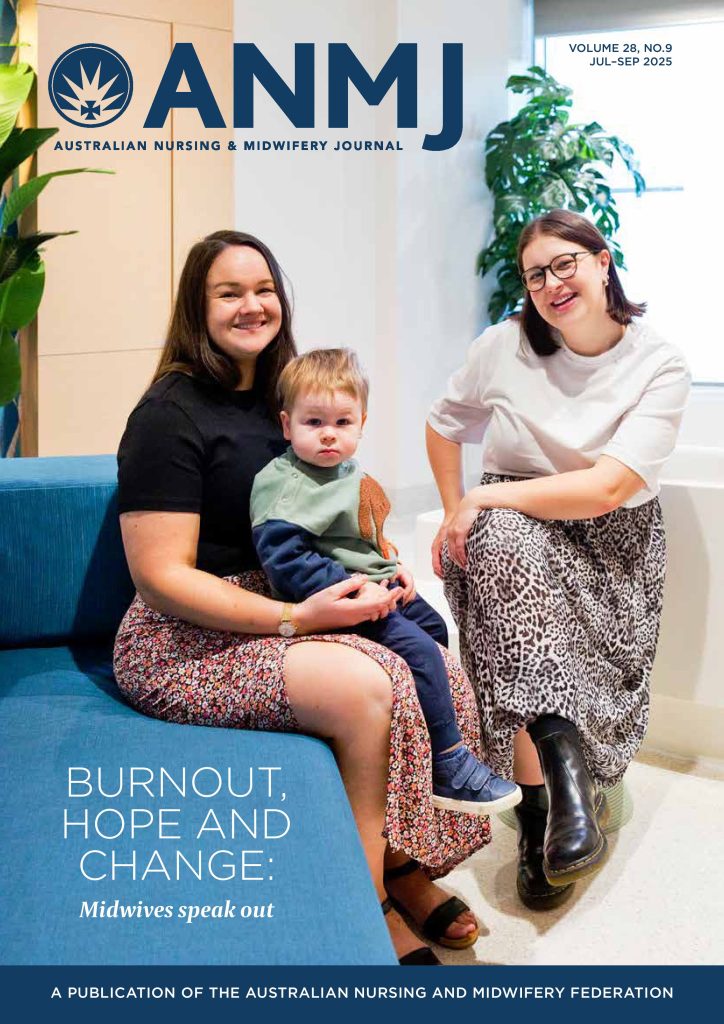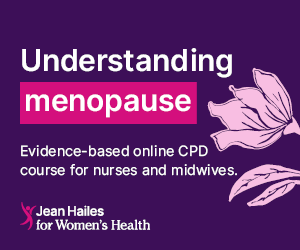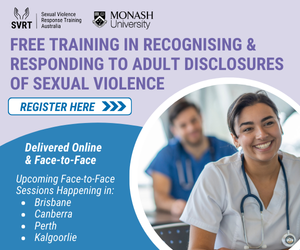I used to be able to work for three days in a row and it was fine, but I can’t do that anymore. I’m bloody tired and I get really sore feet and legs. When I was a graduate people would ask my opinion but now if I speak people say, whatever. I thought you would have retired by now.
These are just some of the unique workplace challenges older nurses and midwives face in the workplace, a new Australian study has revealed.
Working as an older nurse or midwife in the health system meant increased fatigue, physical changes such as loss of hearing or vision, and lack of respect and feeling undervalued.
Led by Julie Denton, an RN PhD Candidate at the University of South Australia’s Health and Clinical Science Division, the study interviewed 50 nurses and midwives who worked across a variety of clinical settings and identified as an older worker. The average age of participants was 57, with ages ranging from 46 to 74.
The study identified three main themes – Ageing Body; Youth Focus; and Wise Worker.
The theme Ageing Body related to the increased fatigue and age-related physical changes faced by older nurses and midwives working in the often physically demanding healthcare environment.
Fatigue was the major challenge for participants, with the busy nature of the role of nurses and midwives, including working long shifts with heavy workloads, contributing to increased levels of tiredness and exhaustion. Some reported that it takes them longer to recover between shifts and that they are exhausted at the end of their workday.
‘You’ve got to be thinking constantly, so mentally and physically it’s very draining’, one participant said.
Physical changes, such as the onset of conditions like age-related arthritis and diabetes, or loss of vision or hearing acuity, also affected the ability of many older nurses and midwives to perform to their best, the study found.
One participant spoke of her diagnosis of psoriatic arthritis, saying it reduced her capacity to work: ‘Bending and doing general ward work is really difficult’, she said.
Similarly, 20 of the 50 older nurses and midwives suggested they suffered from some form of pain, most commonly in their back or feet. In total, 42 of the 50 participants acknowledged they suffered increased fatigue, especially when they were on their feet all day or experienced interrupted sleep patterns.
The second theme identified within the study, Youth Focus, uncovered that for many participants, being an older worker in healthcare meant being viewed as a poor-quality worker, and being afforded limited access to education and promotional opportunities.
Several participants felt their contribution to the workplace was not valued as much as their younger colleagues. One person suggested her workplace did not value older workers because they were nearing retirement, and therefore, did not have longevity.
‘When I was a fresh graduate people would ask my opinion, but now if I speak, people say, ‘oh whatever’’, a participant said.
Older nurses and midwives who took part in the study also reported being treated differently in the workplace, including being shunned by younger colleagues because of their age.
Challenges included being ostracised by younger colleagues and left out of social activities; being constantly asked to cut back on hours; and being labelled slower and criticised by younger colleagues.
Several participants also noted that when working with younger managers, there was little consideration given to them as older workers and that they felt disadvantaged because of their age.
Wise worker was the final theme that emerged from the study.
Contrary to the negative experiences reported by many participants, a small number of older nurses and midwives felt valued and respected for their knowledge, experience and skills, and said they were treated well at work. Several others also spoke about inclusive workplaces with no difference in the treatment between generations.
‘I am looked on as being the wise old woman, the person younger ones come to’, one participant said.
In these workplaces, for some participants, being an older nurse or midwife meant that they were given the opportunity to mentor junior colleagues.
The study was partly driven by data showing Australia’s older nurses and midwives mark the largest rising group of the healthcare workforce. Many are increasingly delaying retirement, continuing to work for numerous reasons such as financial, the camaraderie of working with others, or simply because they are not ready to step away.
Other considerations included the gradual increase of the age pension age, meaning people are increasingly working past the traditional retirement age.
The study’s findings highlight that there is a need to support older nurses and midwives to manage age-related fatigue and physical changes.
One strategy to recognise the important contribution that older workers can make, it suggests, is a ‘wise-worker’ model, where workplaces have practices that enable and facilitate the contribution of older workers.
“The ‘wise-worker’ model of practice is one that should be promoted by all healthcare workplaces to ensure the knowledge and skills of the profession are passed from one generation to the next.”
Mrs Denton said the findings of the study underline the need for more research, particularly about which strategies are most effective to enable older workers in healthcare to meaningfully contribute to the workplace.
“Some spoke of having supportive working lives however, many do not, therefore considering the wide age range of participants identifying as older workers, 46 to 74 years there are ‘young older’ people in the workforce who will be remaining in paid work for many years to come and to help them contribute providing high quality healthcare, they must be supported.”









25 Responses
Although I am an older nurse, I find the young nurses are less resilient and have difficulty coping with nightshift. All nurses across the age spectrum are having difficulty coping with workloads and dealing with fatigue
Thank you for this, it definitely highlights the need to look at the wise-worker model.
Older nurses do need just as much support as newer nurses, they need to be asked are they ok and what do they need to keep going whether that be a more flexible working arrangement or shorter working hours.
After hospital training in the 1980’s I worked as an RN and RM both in Australia and in London.
Australian nurses were respected in all of the hospitals in the UK.
After returning home starting a family I combined studying Law, agency work and 3 pregnancies and small children for 10 years. Eventually I had to concentrate on children. After 5 years with no practice- I was on the scrap heap- all registrations via hospitals lost.
I had to do the 3 year degree course to gain my qualifications again and reregister.
Nothing in the IBNU is designed for Re entry or mature age….I was talking with another older student and a young girl came to chat with us. In her words “I’m not like those other students who think that you should have made up yourmind about career pathways years ago”!!
I was bullied on placement- for either seeming too confident or trying to seek out experiences too early. Not biding my time. Or.. I was dumped with patients on my first days, no mentoring, no orientation etc because the staff were stretched and they figured that I could manage without help. Uni said it was up to us to chase our own learning experience. Hospital staff did not want to supervise and said do you think that you are too good for menial tasks!! I was paying for an education- not free slave labour cleaning out ICU rooms! The degree of Ageism astounded me.
As an older nurse just reaching retirement age , I find the resilience of the younger generation lacking considerably. As a scrub nurse for over 40 yrs I am amazed at the younger generation who need a break every 3-4 hours and the thought of scrubbing for a whole list is just not acceptable to them. Being scrubbed for 8-10hrs case was never an issue – it was what we signed up for! I would still prefer to be scrubbed for 8 hours than scouting for the same length of time.
A young nurse said to me recently that times have changed and we should not be expected to scrub for more than 4 hours at a time – the junior nurses no longer consider the patient – they come scrub for 4 hours, scrub out and leave shortly after – it is like a production line.
The workforce today is so tied up in Policy and process that the patient is well down the line of consideration.
I did hospital based training, plus a degree, a diploma in management and 2 x cert 4s . I was a ‘go-getter’, but now I’m tired. I’m woried about the loss of caring that I am witnessing in young nurses… I am worried about the caseload… It is a big burden to carry, but we battle on.
Documentation is the priority…. Not the patient!! . I’m woried about the nurse that will nurse me!
Well said! ????
I am an older nurse if 65 years of age. I work in aged care I am lucky my young nurses look up to me and I have earned their respect they find me to ask my clarification that they are doing something right or ask my advice if they are not sure what to do.
I am blessed with all these comments because we are all nurses young or old ,the younger nurses are settling in to find there places while we older nurses can look beyond this and set the pace for older and wiser working models
We will find our way
The older I get the more respected I feel.
I do tire more easily but feel my value has shifted from the amount of hours I can do, or the share volume of tasks I am able to complete, to my knowledge, experience and poise under pressure.
I wish networks would make it easier for senior staff to move into less physical roles such as education, formal mentors, management and other less physically demanding roles thus extending the working life of nurses as we age. I also wish that we could do away with forced rotation of rosters so we loose less nurses to sectors other than acute.
I ‘m 61 and find the young RN’s are very respectful and willing to ask questions and learn. The training is so very different from the hands on hospital training that I started in 1978. There are pros and cons for both methods of training. Ideally a combination of both systems would provide improved skills and increased confidence for the new grads. I’’m now working 0.6 and am lucky enough to have left shift work behind.
Hi, l am 62, I work in aged care, dementia ward, on a good day, when the shift flows, work is ok, but when a patient is sick or palliative etc. I struggled with work load, feeding, hygiene and doing medications. I often sit on my car after work and cry. I can work from 3 to 5 shifts a week. By day 5 I am done. I say to my husband when I get home. Do not talk to me just let me sit quietly. I enjoy my work place but the work load I find very demanding. I need to work for a few more years. I often wonder how I am going to manage.
I am 63 an EEN. Because of that my pay is lower I need to work longer hours to financially survive until I retire at 66 1/2 y.o. I don’t know how. Check out at Also looks like a good alternative as the pay is not much left.b you can sit down and no shift work. What a shame to lose my knowledge as there appears not much future employment opportunities as a nurse being supported as I get older. It is a heartwrenching dilemma
I wish I could edit my comments. I must have been tired when I wrote this.
Very interesting comments ,as a n EN (shock horror) I have had 40 plus years as a scrub/scout . I have very rarely come across negative comments .I am now at 69 working for a surgeon with a rooms based minor surgical practice . I only have wonderful memories of the young RNs starting in theatre . Nothing beats experience, good communication and kindness
64 and 4 months. Its definitely harder 12hr. Shifts and I refuse 3 in a row. My back and feet can’t do it anymore. I actually returned to night shift because I rarely had a moment to rest. You know the drill. Sleep pattern on nights stinks but I can catch my breath. Retiring at 65! Put a fork in me, done.
The older nurse brings experience, knowledge and support to the workforce. This is so under valued by management. ( we are too expensive! )For our profession to grow we need the mix to pass on the methods both practical and theory. Recently we loss the use on our IV machines and had a cyber attack going back to basic drip count and paper didn’t faze the older nurse and alerted the younger nurse that our calming can do this attitude kept the care going for our patients. I’m a nurse of over 38 years my daughter is a student nurse let’s hope our combined skills will be recognised and valued as our patients see it does. I am tired and get frustrated but have stamina and am patient focussed this is what need to pass on
I find it interesting so many comments are undermining younger nurses wanting to follow fatigue management and advocating for themselves so they don’t burn out and get injured . Followed by a complaint of fatigue and injury … we have learnt from you this is why we have policy it’s to protect ourselves as our scope gets bigger our hospitals get busier and our workforce continues to group .
Yes younger generations are putting their health first because we know if we aren’t well mistakes are made and we will not be providing good care .
In the same vein so many older nurses refuse to apply and be open to new evidence and best practice because it wasn’t how they were taught but say young nurses aren’t adaptable ?
Young nurses are not going to be the scapegoat because we are advocating for better working conditions and rights we appreciate and respect the struggles , knowledge and service of our senior staff but struggling shouldn’t be a right of passage in nursing . It should be seen as something we want to minimise . Nursing is hard enough as it is we need to stop the division in old vs new it’s a toxic culture , both sides have responsibility to work cohesively and learn from each other .
As someone who works in an amazing team with a huge variance in age it’s not each other fault if execs are overlooking older staff for promotion that is not a younger nurses fault.
I’ve worked as an enrolled nurse, registered nurse and now a midwife on and off since 1972. I’m now working a 6 day fortnight in a very busy maternity unit on a rotating shift roster. I have observed all our staff find it ‘hard’ to ‘cope’ with shifts, changes in practice and workloads.
It’s not easy to be kind to each other especially when there is perceived and real lack of respect in the health industry. Time to take stock- evaluate why we are there and do our job well.
????
Night shift is my challenge, not sleeping takes longer to recover from.
I am fortunate to work with a great group of nurses, various ages where there is mutual respect and support across the team.
I am a clinical nurse aged 55 trained in hospital worked all my career in the public system . I agree that as I age my body hurts recovery from long days and night shift takes longer . The amount of non nursing jobs such as paperwork updating computer programs has increased resulting in less time in a shift to CARE for our patients.I believe the University training is lacking from some places the grads come out unprepared for the realities of shift work scared of making errors .I am in a rural facility have been for 27 years at this facility I find the grads and new staff respect my knowledge but management do not .if I bring concerns to management they brush me aside .
Define older.
I trained as an EEN in 2008 when aged 40. For afternoon shift, a young, sub-30 aged woman would be put in charge on the ward – and did not know how to communicate with the man much older and waiting to be delegated tasks. This happened with at least two different RNs.
So, instead, I got the silent treatment, murmurs and speaking under ones breath. There certainly was a lack of respect.
And in the end there was a freeze on hiring in the NSW public sector… so frustrating all-round. I was treated for a full-year as a bed-maker in a hospital on the outskirts of Sydney.
I am 62 years old and I have been nursing for over 40 years. I have worked from the age of 17 and have had a total of 11 months to have my three children.
I have only worked in a hospital, on the busy wards.
I am NZ trained and have worked in Australia for the last 13 years. I currently work In a large private hospital full time in a heavy medical ward. I work 12 hour shifts as a clinical nurse. I also work in casual pool at a public hospital.
I am respected by all my nursing colleagues. I can hold my own when I am working on the floor. But I must admit I am starting to feel aches and pains in my body. But that is also because I played elite sport until I was 38 years old. I am a very positive and competitive person and that what keeps me going. I have seen and been involved in a lot of changes over the years .
As a 57 year old nurse working now in mental health I’ve shifted my career several times, from ward work, to NUM to accommodate my children, then to mental health.
Fatigue is a daily struggle for me. I’ve had breast cancer treatment and subsequent reconstruction surgery, I have back issues from the days of physically lifting patients. My current job requires a lot of computer time typing extensive assessments and it is very hard on my back. I’ve no intention of retirement, I’m doing a Master of NP currently. I wish there was a way to reduce fatigue but continue with wages that will enable a comfortable retirement, my years of part time work dye to children have considerably affected that money and I’d be lucky to finish work at 70.
As an older nurse, I’m 64 and have been nursing for 46 years, I have witnessed a revolution of changes in nursing. I often feel greatful with some of my colleagues and more than grumpy with others. Sometime my allocations are great but often I get the heaviest load of patients on the unit, often the allocations are split so that I must walk from one end of the unit to the other, I have had both hips and both knees replaced due to arthritis. A few years ago a younger colleague decided it was time I retired, she said those words to my face and to all my other colleagues, and she actively bullied me along these lines until recently when she was moved from my unit. I am a very experienced general nurse, did a lot of remote area work in the early years. I have also taken whatever opportunities came my way and have worked in several countries overseas, and have done some work with refugees. I did my Master of Nursing (Intensive Care)and have been working in ICU for 30 years. I stay up-to-date and I am passionate about what I do and can still contribute to nursing and patient care. I wish everyone felt the way I do about what I do.